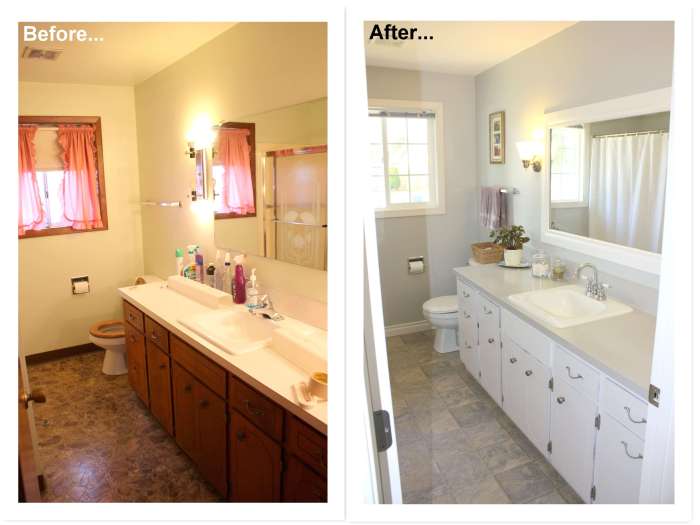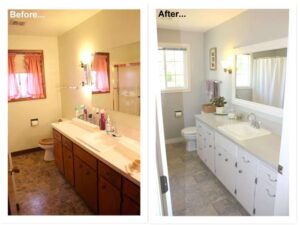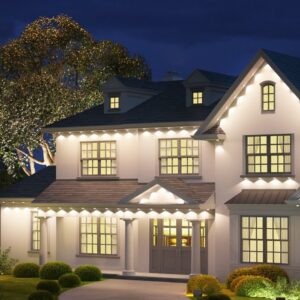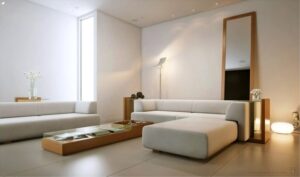
With Bathroom remodel inspiration leading the way, this journey unfolds a canvas of creativity, encouraging homeowners to reimagine their spaces with flair and function. From sleek modern designs to charming traditional styles, every choice can reflect personal taste while enhancing practicality.
Diving into the world of bathroom renovations reveals a myriad of design styles, color palettes, and innovative features that not only beautify but also elevate the functionality of the space. Whether you are looking to create a serene oasis or a vibrant statement, this guide offers the insights and ideas needed to inspire your next remodel.
Bathroom Design Styles
When considering a bathroom remodel, understanding the various design styles can significantly influence the final outcome. Each style possesses unique characteristics that can enhance both aesthetics and functionality, making it easier to choose a direction that resonates with personal taste as well as practical needs. From sleek modern lines to the intricate details of traditional designs, the options are abundant, allowing for customization that reflects individual preferences.Bathroom design styles can broadly be categorized into modern, traditional, and eclectic, each with distinct elements that define them.
Exploring these styles will provide inspiration for creating a space that is both beautiful and functional. The key is to identify the defining features of each style and to think creatively about how they might be combined for a unique look that aligns with your vision.
Modern Bathroom Design
Modern bathroom design is characterized by clean lines, minimalism, and a focus on functionality. This style often incorporates the following elements:
- Neutral Color Palette: Modern bathrooms frequently utilize shades of white, gray, or beige, creating a serene and uncluttered atmosphere.
- Sleek Fixtures: Fixtures with smooth, geometric shapes, such as wall-mounted faucets and streamlined vanities, emphasize efficiency and style.
- High-Tech Features: Incorporating smart technology, such as motion-sensor lighting and digital shower controls, enhances convenience and luxury.
- Open Spaces: Modern designs often favor open layouts, making the space feel larger and more inviting.
Traditional Bathroom Design
Traditional bathroom design recalls classic aesthetics and timeless elegance. Key elements of this style include:
- Rich Color Schemes: Warm, inviting colors such as deep blues, greens, or earth tones are often used.
- Ornate Details: Decorated vanities, intricate moldings, and decorative tiles can add character and warmth.
- Classic Fixtures: Sinks and tubs with vintage designs, such as clawfoot bathtubs and pedestal sinks, bring a nostalgic charm.
- Natural Materials: Wood and stone are commonly used to create a rustic yet refined feel.
Eclectic Bathroom Design
Eclectic bathrooms blend various styles and elements, resulting in a personalized and unique space. This style is defined by:
- Diverse Elements: Mixing contemporary fixtures with vintage pieces allows for creative expression.
- Bold Colors and Patterns: Using vibrant colors, patterned tiles, or unique wallpaper can create visual interest and a lively ambiance.
- Variety of Textures: Combining different materials, like glass, metal, and wood, adds depth and character to the design.
- Personal Touches: Incorporating personal items or artwork can make the space feel uniquely yours.
Blending different styles can lead to a truly distinctive bathroom. For instance, integrating modern fixtures into a traditional layout can create a fresh yet classic look. Another idea is to use eclectic tile designs in a contemporary format, marrying the old with the new in a cohesive manner. Emphasizing the strengths of each style offers endless possibilities for creativity in your bathroom remodel.
Color Schemes and Materials
Choosing the right color scheme and materials is essential for creating a bathroom that not only looks beautiful but also feels inviting and functional. In this space, where relaxation meets utility, the combination of colors and textures can significantly influence the overall atmosphere. Let’s explore some popular color schemes and the materials that can elevate your bathroom’s design.
Popular Color Schemes
Selecting a color scheme can set the tone for your bathroom, harmonizing the various elements of design. Here are some popular color schemes to consider:
- Soft Neutrals: Shades like beige, taupe, and soft gray provide a calming backdrop and can make the space feel larger.
- Bold Blues: Navy or cobalt blue creates a dramatic effect, paired beautifully with white fixtures for a nautical feel.
- Earthy Greens: Colors such as sage or olive green bring the freshness of nature inside, promoting relaxation.
- Warm Terracotta: This color adds warmth and pairs well with natural materials, creating a cozy atmosphere.
- Monochromatic Schemes: Using varying shades of one color, like different grays or whites, can give a sophisticated and cohesive look.
Material Choices for Countertops, Flooring, and Fixtures
The selection of materials used in your bathroom can enhance both functionality and style. Here’s a breakdown of trending materials suitable for various surfaces:
- Countertops:
Quartz and granite offer durability and elegance, while laminate provides an affordable option.
Popular choices include:
- Quartz: Non-porous and available in numerous colors.
- Granite: Each slab is unique, adding character.
- Marble: Luxurious but requires maintenance.
- Laminate: Cost-effective and versatile.
- Flooring:
Choosing the right flooring is essential for comfort and safety.
Consider these materials:
- Ceramic Tile: Available in a range of colors and patterns, resistant to moisture.
- Vinyl: Affordable and comes in various designs, including wood and stone looks.
- Natural Stone: Provides a beautiful aesthetic but can be slippery when wet.
- Bamboo: Eco-friendly and offers a unique look.
- Fixtures:
Updating fixtures can transform the overall look of your bathroom.
Options to consider:
- Stainless Steel: Durable and modern, resistant to rust.
- Brushed Nickel: Offers a soft sheen, complementing various color schemes.
- Matte Black: Provides a bold contrast and a sleek, contemporary feel.
- Brass: Adds warmth and a vintage touch.
Comparison of Bathroom Materials
When renovating your bathroom, understanding the pros and cons of various materials can guide your selection process. Below is a table that compares some common materials:
| Material | Pros | Cons |
|---|---|---|
| Quartz | Durable, non-porous, low maintenance | Can be expensive |
| Granite | Unique appearance, heat resistant | Requires sealing, heavy |
| Ceramic Tile | Variety of designs, waterproof | Can be cold and hard underfoot |
| Vinyl | Inexpensive, easy to install | Can be prone to tears and fading |
| Natural Stone | Beautiful aesthetic, unique | Expensive, requires maintenance |
Functional Features and Innovations

Incorporating functional features and innovative technologies within your bathroom remodel can significantly enhance both usability and comfort. From smart fixtures that streamline daily routines to clever storage solutions that maximize space, these enhancements not only elevate the aesthetic but also add practical value to your home.One of the key aspects of modern bathroom design is the integration of innovative features that improve functionality and comfort.
Smart toilets, for instance, offer advanced options such as automatic flushing, heated seats, and integrated bidets, bringing a touch of luxury while improving hygiene. Heated floors are another popular innovation, providing warmth during chilly mornings and enhancing overall comfort. These features not only provide convenience but also contribute to a more enjoyable and efficient bathroom experience.
Smart Storage Solutions
Maximizing storage space is crucial, especially in smaller bathrooms where every inch counts. Clever storage solutions can help you maintain a clutter-free environment while ensuring that all necessary items are easily accessible. Here are some effective options to consider:
- Wall-Mounted Shelves: These shelves utilize vertical space, perfect for displaying decor or storing essentials without taking up floor space.
- Under-Sink Cabinets: Installing cabinets beneath the sink can hide plumbing while providing valuable storage for cleaning supplies and toiletries.
- Over-the-Toilet Storage Units: These units fit snugly above the toilet, utilizing an often-overlooked area for additional storage.
- Multifunctional Furniture: Consider benches or ottomans that open up for storage to keep towels or extra supplies out of sight.
- Built-In Nooks: Recessed shelves in the wall can provide a seamless way to store items like shampoo and soap without cluttering the shower area.
Energy-Efficient Fixtures
Integrating energy-efficient fixtures in your bathroom remodel can lead to significant savings on water and electricity bills while being environmentally friendly. The right choices can contribute to a sustainable home and reduce your ecological footprint. Here are some tips to consider:
- Low-Flow Faucets: Installing low-flow faucets can reduce water usage without sacrificing pressure, making them a smart choice for conservation.
- Energy-Efficient Lighting: Opt for LED lighting instead of traditional bulbs; they use less energy and last longer, making them a cost-effective solution.
- Water-Saving Toilets: Choose toilets that use less water per flush, such as dual-flush models that allow users to select between a full or partial flush, saving water.
- Smart Showerheads: These fixtures can monitor water flow and temperature, ensuring efficiency while enhancing the shower experience.
- Insulated Hot Water Pipes: Insulating your hot water pipes reduces heat loss, ensuring that hot water arrives at the faucet more quickly while using less energy.
“Implementing energy-efficient and innovative features in your bathroom can enhance comfort, improve functionality, and lead to significant savings in the long run.”
Trends in Home Improvement
As homeowners increasingly focus on enhancing their living spaces, bathroom remodels have become a central element of home improvement trends. With a blend of style, functionality, and eco-consciousness, these renovations are evolving to meet contemporary demands. Recent trends reflect a shift towards sustainable practices, the impact of outdoor aesthetics, and the influence of the real estate market on home value.
Eco-Friendly Practices in Bathroom Remodeling
Sustainable home improvement practices have gained traction in recent years, especially in bathroom renovations. Homeowners are now prioritizing eco-friendly materials and technologies that not only minimize environmental impact but also enhance indoor air quality. Key elements include:
-
Use of Low-VOC Paints:
These paints reduce harmful emissions and contribute to a healthier environment.
-
Water-Efficient Fixtures:
Installing faucets and toilets that reduce water usage without sacrificing performance is increasingly popular.
-
Recycled Materials:
Utilizing recycled glass tiles or reclaimed wood for cabinetry promotes sustainability while adding character.
The growing awareness of climate change and resource conservation has led many to seek certifications such as LEED (Leadership in Energy and Environmental Design) for their renovations.
Influence of Gardening and Outdoor Aesthetics
The trend of integrating outdoor beauty with indoor spaces is transforming how bathrooms are designed. Homeowners are looking to create a seamless transition between nature and their personal retreats. The incorporation of natural elements into bathrooms can enhance the overall aesthetic and tranquility of the space.
-
Biophilic Design:
This design principle emphasizes connecting indoor spaces with nature, resulting in more inviting and relaxing environments.
-
Large Windows:
Strategically placed windows can frame outdoor views, bringing in natural light and reducing reliance on artificial lighting.
-
Indoor Plants:
Adding greenery through potted plants or vertical gardens can improve air quality and create a spa-like ambiance.
These elements not only elevate the bathroom’s design but also contribute to a serene atmosphere that promotes wellness.
Real Estate Market Trends and Bathroom Renovations
The dynamics of the real estate market significantly influence bathroom renovations, as homeowners aim to enhance their property’s value. Recent studies indicate that well-executed bathroom remodels can yield high returns on investment, making them a strategic choice for homeowners looking to sell.
-
Market Demand:
Homes with updated bathrooms tend to attract more buyers, especially those in competitive markets.
-
Resale Value:
A mid-range bathroom remodel can recoup an average of 70% of its cost, making it a financially sensible renovation.
-
Trends in Buyer Preferences:
Modern buyers often seek bathrooms with spa-like features, updated technology, and energy-efficient designs.
As such, staying attuned to these market trends can guide homeowners in their decisions to remodel and can ultimately enhance property value.
Outcome Summary

In conclusion, transforming your bathroom into a stylish and functional retreat is an exciting venture filled with endless possibilities. By blending design styles, selecting the right materials, and incorporating innovative features, you can craft a space that not only meets your needs but also elevates your home’s value. Embrace the inspiration and let your creativity shine in your next bathroom remodel!
Key Questions Answered
What are the best color schemes for a bathroom remodel?
Popular color schemes include soft neutrals, bold accent colors, and calming blues and greens that create a serene atmosphere.
How can I maximize storage in a small bathroom?
Consider installing floating shelves, using multi-functional furniture, and choosing vertical storage solutions to make the most of limited space.
What are some trending materials for bathroom renovations?
Trendy materials include quartz for countertops, porcelain tiles for flooring, and brushed nickel fixtures for a contemporary look.
How can I integrate energy-efficient features in my bathroom?
Look for low-flow toilets and faucets, energy-efficient lighting, and smart home devices that help reduce water and energy consumption.
What should I consider when blending different design styles?
Focus on a cohesive color palette and choose key elements from each style that harmonize, ensuring the overall look feels intentional and well-curated.





